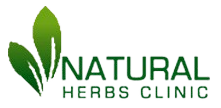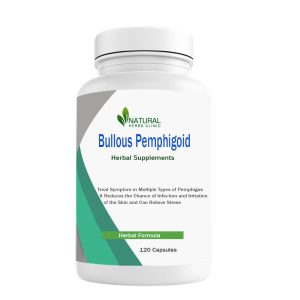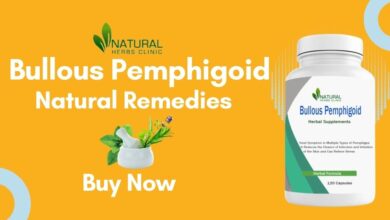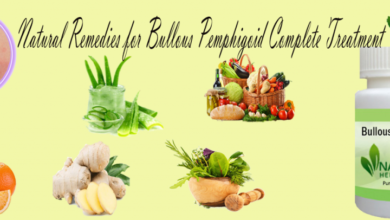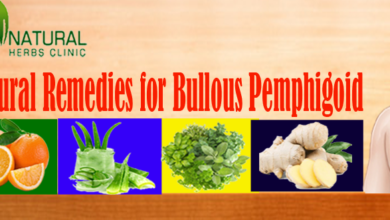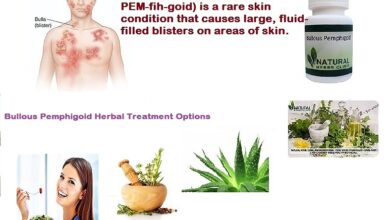Natural Treatments for Bullous Pemphigoid: Effective Healing Remedies
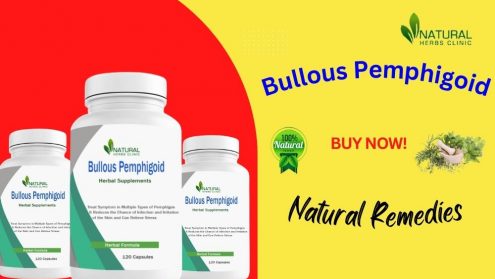
Bullous pemphigoid is an autoimmune skin condition characterized by the formation of large blisters. While medical treatments are crucial for managing this condition, some people look for complementary natural remedies to help with symptoms and healing. Here are some Herbal Treatment for Bullous Pemphigoid that may provide relief:
What is Bullous Pemphigoid?
Bullous pemphigoid is a rare autoimmune skin condition that primarily affects older adults. It occurs when the immune system mistakenly attacks the layer of tissue just beneath the skin’s outermost layer (the epidermis), causing blisters to form. These blisters are large, fluid-filled, and often appear on areas of the body like the arms, legs, abdomen, and sometimes inside the mouth.
Key characteristics of bullous pemphigoid:
Blisters: Usually large, firm, and don’t easily rupture. They can occasionally hurt and irritating.
- Skin Involvement: It typically affects areas of the skin that flex, like the lower abdomen, upper thighs, or armpits.
- Cause: The immune system produces antibodies against proteins in the basement membrane, a part of the skin that holds the outer and inner layers together, leading to blistering.
- Risk factors: Age is a significant factor, with most patients being over 60 years old. Certain medications, radiation therapy, or underlying health conditions can trigger it.
- Treatment: It can be managed with medications like corticosteroids (to reduce inflammation) and immunosuppressants to control the immune system’s response.
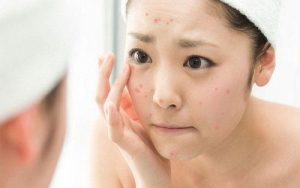
Diagnosis of Bullous Pemphigoid
Bullous Pemphigoid is a rare autoimmune skin disorder characterized by large, fluid-filled blisters (bullae) primarily on areas of skin that often flex, such as the lower abdomen, thighs, and armpits. It usually affects older adults and can cause significant discomfort due to itching and blister formation.
Diagnostic Steps for Bullous Pemphigoid
-
Clinical Presentation:
- Patients typically present with itchy, tense blisters on normal or inflamed skin. The blisters may be located on the trunk, limbs, or mucous membranes.
- Sometimes, patients experience intense itching and redness before blisters appear, and blisters may be absent in early cases.
-
Skin Biopsy:
A skin biopsy is the most reliable method for identifying bullous pemphigoid. Two Typically, two types of biopsies are conducted.
- Perilesional Biopsy for Direct Immunofluorescence (DIF): This involves taking a sample of skin near the blister to detect immune deposits (usually IgG and C3) along the basement membrane, confirming the autoimmune nature of the disease.
- Lesional Biopsy for Histopathology: This involves examining the blister under a microscope to look for a subepidermal blister with an inflammatory infiltrate, primarily consisting of eosinophils.
-
Serological Tests:
- Indirect Immunofluorescence (IIF): This test examines the patient’s blood for antibodies to the skin’s basement membrane zone.
- ELISA (Enzyme-linked Immunosorbent Assay): This test measures specific antibodies (anti-BP180 and anti-BP230), which are often elevated in bullous pemphigoid.
-
Differential Diagnosis:
- It’s essential to distinguish bullous pemphigoid from other blistering conditions like pemphigus vulgaris, dermatitis herpetiformis, linear IgA dermatosis, and epidermolysis bullosa acquisita. This is done through clinical evaluation and immunopathological studies.
-
Other Evaluations:
- Complete Blood Count (CBC): Eosinophilia is often seen in patients with bullous pemphigoid.
- Other Blood Tests: Basic metabolic panel and liver function tests are sometimes conducted to rule out other systemic involvement or to monitor for side effects of medications.
How to Treat Pemphigoid Bullous Naturally
Bullous pemphigoid is a rare autoimmune skin condition that causes large, fluid-filled blisters on the skin. While medical treatments like corticosteroids and immunosuppressants are often essential for controlling the condition, there are also natural approaches that may help manage symptoms and support skin healing. However, always consult a healthcare provider before trying alternative treatments.
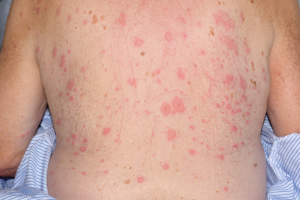
Here are some natural strategies that may complement conventional treatments for bullous pemphigoid:
-
Anti-inflammatory Diet
By reducing inflammation, an anti-inflammatory diet may help lessen flare-ups.. Include foods such as:
- Fruits and vegetables, especially those rich in antioxidants, such as leafy greens and berries
- Omega-3 fatty acids, which are present in salmon, flaxseeds, and walnuts
- Whole grains, including brown rice, quinoa, and oats.
- Avocados and olive oil are good sources of fat.
- Avoid inflammatory foods including processed foods, refined carbs, and excessive amounts of red meat.
-
Probiotics
Since autoimmune disorders are sometimes linked to gut health, incorporating probiotics (good bacteria) may help. Foods high in probiotics include kimchi, miso, kefir, sauerkraut, and yoghurt. You can also consider taking a probiotic supplement, but consult a healthcare provider first.
-
Vitamin D
Vitamin D has immune-modulating properties and may help regulate the immune system in autoimmune conditions. Safely exposing yourself to sunlight or taking a vitamin D supplement (with your doctor’s advice) could be helpful.
-
Aloe Vera
Aloe vera gel can be soothing for irritated skAloe vera gel can soothe inflamed skin. Applying pure aloe vera gel directly to affected areas may help reduce discomfort, itchiness, and inflammation.
-
Turmeric
Curcumin, turmeric’s major component, is both antioxidant and anti-inflammatory. Taking turmeric as a supplement or adding it to food may help reduce inflammation. To improve absorption, it’s crucial to consume it with black pepper
-
Chamomile
Chamomile can help the skin because of its calming and anti-inflammatory qualities. You can use chamomile tea as a topical wash or soak to relieve itching and inflammation.
-
Oatmeal Baths
Oatmeal baths can help soothe irritated skin. Colloidal oatmeal, which is finely ground oats, can be added to lukewarm water to reduce itching and inflammation.
-
Stress Management
Stress can trigger or worsen autoimmune conditions. Yoga, meditation, deep breathing techniques, and regular exercise are all effective ways to reduce stress.
-
Avoid Triggers
Identify and avoid personal triggers that may exacerbate your condition. This could include certain foods, chemicals, or environmental factors.
-
Moisturize Regularly
Keeping the skin hydrated with natural, odorless lotions or oils (such shea butter or coconut oil) will help protect it and decrease irritation.
-
Herbal Remedies
Herbal remedies that support the immune system and reduce inflammation include boswellia, green tea, and ginger. A healthcare provider should always be consulted before beginning any herbal supplementation.
-
Acupuncture
Some individuals find acupuncture beneficial for autoimmune conditions. It may help reduce symptoms and improve overall well-being, though scientific evidence is limited.
Supplements for Bullous Pemphigoid
particularly corticosteroids and immunosuppressants. However, some supplements may be used alongside conventional treatment to support overall health and potentially aid in managing the condition. Before using any supplements, always consult with a healthcare practitioner. Some options to consider include:
-
Vitamin D
- Why: People with autoimmune conditions, including bullous pemphigoid, often have low levels of vitamin D. It promotes immune system modulation and may aid Bullous pemphigoid is a persistent autoimmune skin condition that creates enormous, fluid-filled blisters in primarily older persons. The primary treatment is usually medication, reduce inflammation.
- Dosage: Consult with your doctor for appropriate dosing based on blood levels.
-
Omega-3 Fatty Acids (Fish Oil)
- Why: Gut health plays an important part in controlling the immune system. They may also support skin health.
- Dosage: Typically, 1–3 grams per day, but consult with your doctor.
-
Probiotics
- Why: Gut health plays a significant role in regulating the immune system. Probiotics may help support the gut microbiome and modulate immune responses in autoimmune diseases.
- Sources: Fermented foods or supplements.
-
Vitamin E
- Why: Vitamin E contains antioxidants that may help protect the skin and minimize oxidative stress, which contributes to inflammation.
- Dosage: Typically around 200–400 IU per day, but it’s essential to consult with a doctor.
-
Zinc
- Why: Zinc supports immune function and wound healing, which could help in managing skin lesions from bullous pemphigoid.
- Dosage: Around 15–30 mg per day, but excessive intake should be avoided without medical advice.
-
Curcumin (Turmeric)
- Why: Curcumin is a powerful anti-inflammatory compound that may help reduce inflammation and immune system overactivity in autoimmune conditions.
- Dosage: 500–1000 mg of curcumin extract per day, ideally with black pepper to enhance absorption.
-
B-Complex Vitamins
- Why: B vitamins, especially folate and B12, can boost immune function in general and may be beneficial for autoimmune diseases.
- Dosage: Take a B-complex supplement or consume the required amount each day.
-
Quercetin
- Why: Quercetin is an anti-inflammatory flavonoid that may aid with inflammation management.
- Dosage: Typically, 500–1000 mg per day, but consult a doctor.
-
Collagen Supplements
- Why: Since bullous pemphigoid affects the skin, collagen supplementation may support skin integrity and healing.
- Dosage: Follow manufacturer recommendations, usually around 2.5–15 grams per day.
-
Aloe Vera (Topical and Oral)
- Why: Aloe vera’s anti-inflammatory and skin-soothing qualities may help reduce skin irritation.
- Usage: After speaking with a physician, apply aloe vera gel topically or take oral aloe vera supplements.
Important Notes:
- While these supplements might provide further assistance, they shouldn’t be used in place of prescription drugs.
- Always inform your healthcare provider before starting any new supplement, as interactions with medications or side effects could occur.
- Regular monitoring by a healthcare professional is crucial, especially with autoimmune conditions like bullous pemphigoid.
Remedies for Bullous Pemphigoid
Large, fluid-filled blisters are the main symptom of bullous pemphigoid, a chronic autoimmune disease that mostly affects the skin. While medical treatment (usually corticosteroids and immunosuppressants) is essential for controlling the condition, some natural remedies and lifestyle adjustments can complement the standard treatments. Before attempting any home cures, it’s crucial to speak with a healthcare professional.
Here are some Natural Remedies For Bullous Pemphigoid that may help manage symptoms of bullous pemphigoid:
-
Cold Compresses
- Why: Blistered areas may benefit from using a cold compress.
- How: Use a clean, damp cloth and apply it to the affected area for 10–15 minutes. Repeat as needed.
-
Aloe Vera Gel
- Why: Aloe vera can help soothe inflamed skin because of its calming, anti-inflammatory, and restorative qualities.
- How: Apply pure aloe vera gel to affected areas. Verify that there are no additional chemicals or perfumes present.
-
Gentle Skin Care
- Why: Because harsh chemicals and soaps can exacerbate skin sensitivity.
- How: To preserve the skin’s barrier, use gentle, fragrance-free cleansers and moisturizers. Consider emollients like shea butter or oatmeal-based creams.
-
Anti-Itch Remedies
- Why: One typical and irritating sign of bullous pemphigoid is itching.
- How: Colloidal oatmeal baths can help soothe itching. Add ground oatmeal to lukewarm bathwater and soak for 15–20 minutes.
-
Diet Adjustments
- Why: Some foods may trigger inflammation, so a diet rich in anti-inflammatory foods may help.
- How: Incorporate foods like leafy greens, berries, fatty fish (rich in omega-3s), nuts, and seeds. Avoid processed foods, refined sugars, and saturated fats. If a specific food triggers flare-ups, consider eliminating it from your diet.
-
Probiotics
- Why: Since the immune system and gut health are connected, maintaining a healthy gut may help manage autoimmune reactions.
- How: Consume probiotic-rich foods like yogurt, kefir, sauerkraut, or consider taking a probiotic supplement.
-
Turmeric (Curcumin)
- Why: Curcumin, the active compound in turmeric, has strong anti-inflammatory and antioxidant effects.
- How: Take curcumin supplements or incorporate turmeric into your diet. Black pepper enhances curcumin absorption, so include both together if possible.
-
Quercetin
- Why: Quercetin is a plant flavonoid that has anti-inflammatory and antihistamine properties, which may help manage skin irritation and immune responses.
- How: Quercetin supplements are available, or you can consume foods high in quercetin like apples, onions, and berries.
-
Chamomile Tea (Topical)
- Why: Chamomile has soothing and anti-inflammatory properties, which may help reduce skin irritation and promote healing.
- How: Brew chamomile tea, let it cool, and apply it to the affected areas with a clean cloth.
-
Avoid Triggers
- Why: Certain triggers, like stress, extreme temperatures, or sun exposure, can worsen symptoms.
- How: Identify potential triggers and avoid them. Practice stress management techniques like meditation, deep breathing, or gentle yoga.
-
Bentonite Clay
- Why: Bentonite clay has detoxifying properties and may help draw out impurities and soothe inflamed skin.
- How: Make a paste with bentonite clay and water, then apply it to the affected skin. Wash off after 10–15 minutes.
-
Apple Cider Vinegar (Diluted)
- Why: Apple cider vinegar has antibacterial properties that may help reduce the risk of infection.
- How: Dilute apple cider vinegar with water and gently apply it to the skin using a clean cotton ball. Be cautious, as it can irritate sensitive skin.
-
Vitamin E Oil
- Why: Vitamin E is an antioxidant that can help promote healing and reduce scarring.
- How: Apply vitamin E oil to affected areas after blisters have healed.
-
Licorice Extract
- Why: Licorice has anti-inflammatory properties that may help soothe skin and reduce itching.
- How: Apply a topical licorice cream or take licorice extract supplements. Always consult your doctor, especially if you have high blood pressure.
-
Rest and Hydration
- Why: Staying well-hydrated and getting enough rest can help support the body’s healing process.
- How: Drink plenty of water and get sufficient sleep to allow the body to recover.
Important Reminders:
- Medical Treatment: Always follow your doctor’s prescribed treatments. Home remedies can complement, but not replace, medical therapy.
- Consult Healthcare Providers: Speak with your healthcare provider before starting any new treatments or remedies to ensure safety and effectiveness, especially if you’re taking medications.
- Monitor Skin Changes: Keep an eye on the condition of your skin and inform your doctor of any worsening symptoms or new developments.
- Effective management of bullous pemphigoid often requires a combination of medical treatment, lifestyle changes, and supportive remedies.
Natural Treatments for Bullous Pemphigoid
Bullous pemphigoid is an autoimmune skin condition that causes large, fluid-filled blisters, primarily in older adults. While medical treatments (like corticosteroids and immunosuppressive drugs) are the primary approach, some natural remedies may help alleviate symptoms or complement medical treatment. However, it is important to consult with a healthcare provider before trying any natural treatments.
Here are some natural options that may support management:
-
Dietary Adjustments
- Anti-inflammatory Diet: Foods rich in anti-inflammatory properties (e.g., fruits, vegetables, nuts, seeds, and fatty fish) may help reduce skin inflammation.
- Avoid Allergens: Some people report improvements when they eliminate gluten, dairy, or other common allergens. A food sensitivity test may help identify triggers.
- Probiotics: These promote gut health and immune regulation, which may be beneficial for autoimmune conditions.
-
Supplements
- Vitamin D: Low levels of vitamin D have been linked to various autoimmune diseases. Vitamin D supplements may help strengthen the immune system.
- Omega-3 Fatty Acids: Found in fish oil or flaxseed, omega-3s have anti-inflammatory properties that may help reduce skin inflammation.
- Turmeric (Curcumin): Known for its anti-inflammatory effects, curcumin may help in reducing flare-ups. Think about taking pills or adding turmeric to food.
-
Herbal Remedies
- Aloe Vera: Topical aloe vera gel may soothe irritated skin and promote healing of blisters.
- Calendula: Known for its wound-healing properties, calendula cream or ointments can help soothe skin and speed up recovery.
- Chamomile: Chamomile creams or baths can have soothing effects on inflamed skin.
- Tea Tree Oil: Diluted tea tree oil has antimicrobial properties that may help prevent secondary infections on the skin.
-
Stress Management
- Meditation and Yoga: Stress is a common trigger for autoimmune flare-ups. Mindfulness techniques such as meditation, deep breathing, and yoga can help manage stress levels.
- Acupuncture: This traditional Chinese medicine practice may help reduce stress and improve immune system balance.
-
Natural Skincare
- Oatmeal Baths: Colloidal oatmeal can help soothe itching and reduce inflammation. Adding it to bath water may ease symptoms.
- Cool Compresses: Applying a cool, damp cloth to the affected areas can relieve itching and discomfort.
- Gentle Cleansers: Use fragrance-free and hypoallergenic skin care products to avoid irritating sensitive skin.
-
Lifestyle Changes
- Gentle Exercise: Engaging in mild physical activity like walking or swimming can improve circulation and support overall well-being.
- Moisturizing: Keeping the skin well-moisturized with gentle, non-irritating lotions can prevent dryness and flare-ups.
-
Homeopathy and Alternative Medicine
- Some people explore homeopathic remedies or consult naturopaths for individualized treatments, though scientific evidence for these approaches remains limited.
Important Considerations:
- Avoid Sun Exposure: Sunburn can exacerbate symptoms, so using sunblock and protective clothing is crucial.
- Hydration: Staying well-hydrated supports skin health.
